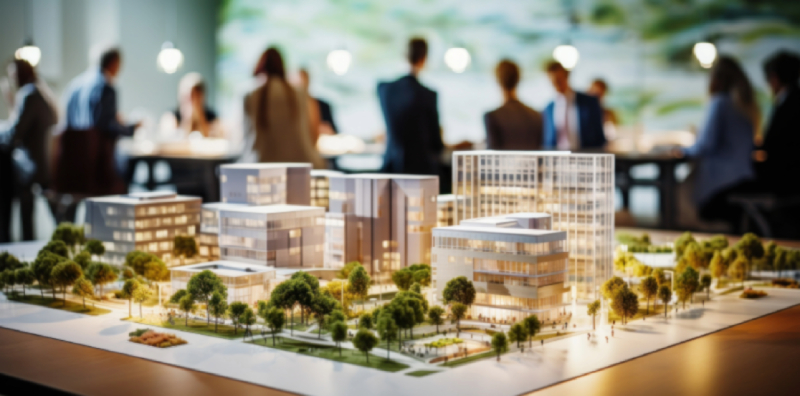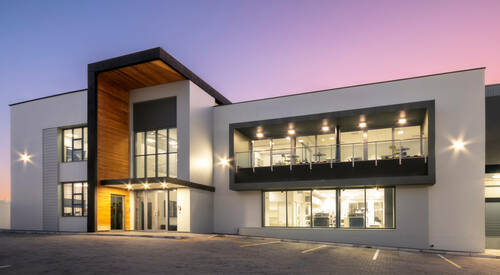Revealing the Comprehensive Solutions Given by Commercial Architects for Modern Developments
Commercial Architects offer an essential feature in modern advancement tasks. They mix style aesthetics with performance while adhering to governing requirements. Their competence prolongs past simple building and construction, including sustainable practices and ingenious innovations. As they navigate complex zoning regulations, Architects work together with various stakeholders to bring visions to life. This complex method questions about the progressing function of Architects fit contemporary rooms and the effect of their work with future advancements.
Comprehending the Function of Commercial Architects in Modern Developments
In contemporary urban landscapes, Commercial Architects play a critical role fit functional and visual areas that satisfy diverse business requirements. Their proficiency extends past plain style; they navigate complex zoning legislations, developing codes, and environmental policies. By collaborating with customers, they determine certain requirements, guaranteeing that each task aligns with the customer's vision while additionally thinking about functional aspects such as sustainability and cost-effectiveness. Commercial Architects are adept at integrating cutting-edge innovations and products right into their styles, improving both the functionality and energy efficiency of structures. They perform thorough site evaluations to analyze the potential challenges and opportunities presented by an area. Additionally, effective interaction with service providers and other stakeholders is vital, ensuring that the project proceeds efficiently from perception to conclusion. Eventually, Commercial Architects contribute in developing spaces that not only accomplish useful purposes however also add to the general personality and vibrancy of city atmospheres.
Idea Layout: Changing Concepts Into Reality
Principle design works as a vital phase in Commercial style, where cutting-edge style services emerge from innovative brainstorming. This procedure depends on joint ideation, combining diverse perspectives to refine and boost initial principles. As ideas take form, they transform from abstract concepts into concrete architectural truths.
Cutting-edge Layout Solutions
Changing concepts into reality is the hallmark of innovative style solutions in Commercial architecture. These solutions mix creativity with capability, attending to the one-of-a-kind demands of contemporary advancements. By leveraging advanced technologies and lasting methods, Architects craft areas that are not only aesthetically enticing but also reliable and adaptable. Focus on individual experience drives the design process, guaranteeing that environments foster efficiency and collaboration. Each job advantages from a tailored approach, where concepts are diligently established to show the customer's vision while taking into consideration future trends. Cutting-edge layout options additionally prioritize versatility, permitting adjustments with time as organization requirements evolve. Eventually, these methods boost the total value of Commercial rooms, making them crucial in today's competitive landscape.

Joint Ideation Refine
Collaboration acts as the backbone of the ideation process in Commercial architecture, promoting creative thinking and innovation amongst diverse stakeholders. Architects, customers, designers, and community participants participate in vibrant discussions, guaranteeing that all point of views are considered. This comprehensive technique permits for the exploration of various style ideas, encouraging unique options that line up with the project's vision. With workshops and conceptualizing sessions, concepts advance and refine, changing initial concepts right into concrete styles. Modern technology additionally plays a critical function, with devices such as Building Info Modeling (BIM) helping with real-time partnership and modifications. Ultimately, this joint ideation procedure not just enhances the style outcome however additionally cultivates a feeling of possession and investment amongst all parties entailed, leading to effective Commercial developments.
Zoning Evaluation: Navigating Regulations and Conformity
As programmers commence on brand-new tasks, comprehending zoning policies is important to making sure conformity and avoiding expensive delays. Zoning evaluation plays a crucial duty in this procedure, as it involves examining neighborhood zoning laws that determine land usage, building height, density, and troubles. Commercial Architects possess the knowledge to navigate these complicated policies, aiding clients determine acceptable usages and any kind of required variations.
Lasting Layout Practices: Building for the Future
Lasting layout techniques are significantly essential in the domain of Commercial style, especially as ecological worries remain to intensify. Architects prioritize environment-friendly materials, energy-efficient systems, and layout approaches that minimize waste and environmental influence. Integrating sustainable energy sources, such as photovoltaic panels and wind generators, allows buildings to create their very own power and minimize reliance on fossil fuels.Furthermore, sustainable style emphasizes the relevance of indoor environmental top quality. This includes making use of natural light, boosting air flow, and picking safe products to enhance resident wellness and efficiency. Environment-friendly roof coverings and living wall surfaces are additionally preferred attributes that add to biodiversity and urban cooling.Additionally, Commercial Architects commonly integrate water preservation techniques, like rainwater harvesting and drought-resistant landscaping. With these innovative methods, they develop areas that not just fulfill modern requirements but likewise cultivate a sustainable future, attending to the expanding need for responsible This Site growth in the modern world.
Project Administration: Ensuring Timely and Efficient Execution
Effective job monitoring is necessary for making sure that Commercial architecture projects are finished in a timely manner and within budget. This role incorporates an array of obligations, including the coordination of different stakeholders, timelines, and resources. Commercial Architects utilize their proficiency to create in-depth task strategies that detail critical milestones and deliverables, permitting methodical development tracking.Regular interaction amongst staff member and customers is crucial, cultivating transparency and assisting in prompt decision-making. Danger administration techniques are additionally utilized to determine prospective challenges early, allowing aggressive services to be created. By utilizing advanced project administration devices, Architects can check task performance in real-time, making changes as required to keep effectiveness.
Interior Decoration: Creating Functional and Visual Spaces
Inside style plays a crucial function in boosting both performance and aesthetic appeal within Commercial areas. Reliable space preparation can maximize workflow and boost user experience, while visual design principles contribute to an aesthetically appealing setting - commercial architects. With each other, these aspects create spaces that are not only useful but likewise motivating
Room Preparation Effectiveness
While maximizing check my site the energy of readily available area, Commercial Architects prioritize space planning performance to produce both functional and cosmetically pleasing settings. This technique entails cautious evaluation of the spatial design to assure suitable use every square foot. Architects consider variables such as workflow, access, and all-natural light to improve usability. By purposefully placing furniture, tools, and workstations, they assist in movement and communication amongst customers, promoting productivity. In addition, zoning various areas for specific functions helps in handling noise and privacy, creating a harmonious environment. Through reliable room preparation, Commercial Architects can transform constraints right into chances, ensuring that each space fulfills the varied requirements of its owners while adhering to regulative requirements and market requirements.
Aesthetic Style Concepts
Visual design concepts play a crucial role in shaping settings that are not only functional however additionally visually appealing. These concepts guide Commercial Architects in developing spaces that reverberate with customers while improving brand identification. Trick components include balance, proportion, and harmony, which interact to develop a natural look. Shade schemes and products are carefully chosen to evoke preferred emotions and sustain the general theme. In addition, illumination plays a critical role, influencing state of mind and visibility while highlighting architectural functions. By incorporating these concepts, Architects assure that rooms are not only sensible yet likewise inviting and motivating. Ultimately, reliable visual layout cultivates a favorable customer experience, motivating interaction and contentment in Commercial environments.
Cooperation With Stakeholders: Promoting Successful Collaborations
Effective collaborations in Commercial architecture depend upon effective collaboration with stakeholders, guaranteeing that every voice is listened to and valued. This collective strategy includes engaging numerous parties, consisting of customers, specialists, and neighborhood members, throughout the layout and advancement procedure. By fostering open interaction, Commercial Architects can resolve concerns, collect understandings, and align the job's vision with stakeholder expectations.The integration of varied point of views improves creativity and innovation, bring about more practical and cosmetically pleasing layouts. Regular conferences, feedback sessions, and workshops promote this dialogue, allowing Architects to adapt their plans in reaction to stakeholder input. On top of that, developing depend on via openness and accountability enhances these partnerships, leading to a smoother job execution.Ultimately, the success of modern developments depends upon the Architects' ability to navigate and balance differing passions, creating a joint setting that advertises shared objectives and common success.
Often Asked Concerns
Exactly How Do Commercial Architects Handle Budget Constraints During a Task?

What Kinds of Software Application Do Commercial Architects Frequently Utilize?
Commercial Architects commonly utilize software such as AutoCAD for preparing, Revit for Building Info Modeling, SketchUp for 3D modeling, and job monitoring devices like Microsoft Task to enhance cooperation and simplify process throughout the design procedure.
Can Commercial Architects Help With Getting Funding for Projects?
Commercial Architects can assist in obtaining financing for tasks by preparing blog detailed proposals, helping to articulate layout visions, and giving monetary forecasts that can boost the likelihood of securing essential funding from financiers or banks.
How Do Architects Make Sure Safety Throughout the Building And Construction Process?
Architects ensure security throughout building and construction by implementing rigorous style standards, coordinating with designers, carrying out regular site evaluations, sticking to regional policies, and promoting communication among all stakeholders to minimize dangers and promote a safe functioning environment.
What Ongoing Assistance Do Architects Give After Job Completion?
After task conclusion, Architects provide ongoing assistance through maintenance examinations, performance assessments, and style adjustments. They guarantee structures satisfy developing demands, address prospective issues, and keep conformity with guidelines, promoting a lasting partnership with customers.